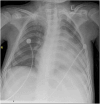A case report of a rare genetic mutation (LMNA-C.185G>C, p.Arg62Pro) associated with dilated cardiomyopathy in a Han Chinese child
- PMID: 39390987
- PMCID: PMC11464412
- DOI: 10.3389/fcvm.2024.1450246
A case report of a rare genetic mutation (LMNA-C.185G>C, p.Arg62Pro) associated with dilated cardiomyopathy in a Han Chinese child
Abstract
Dilated cardiomyopathy (DCM) remains an enigmatic myocardial disorder characterized either by enlargement of either the left or right ventricle or both and reduced contractility, posing a significant burden on pediatric populations as a leading cause of cardiac-related mortality and morbidity. This paper presents a compelling case of DCM in a Han Chinese child whose genomic analysis unveiled a novel LMNA-C.185G>C (p.Arg62Pro) variant. Over a meticulous 3-year clinical follow-up, spanning ten outpatient consultations and hospital admissions since the initial diagnosis, the patient exhibited a progressive emergence of various cardiac conduction anomalies closely mirroring LMNA-associated phenotypes. Delving into a comprehensive review of the patient's 14-year medical journey and familial history, antecedent signs of muscular dystrophy (MD) predated DCM onset. Familial scrutiny revealed a lineage marred by muscular atrophy, with the patient's maternal grandmother having a history of muscular dystrophy and an episode of DCM, necessitating cardiac transplantation in the patient's uncle at age 37. This scenario illuminates the intricate interplay between LMNA-associated diseases and genetic predisposition. Timely identification of etiological triggers stands paramount in DCM management. Beyond conventional genetic scrutiny, leveraging novel serum biomarkers such as anti-heart muscle antibodies (AHA) remarkably enhanced diagnostic precision. Notably, personalized therapeutic interventions comprising prednisolone regimens and intravenous immunoglobulin infusions precipitated marked amelioration in heart failure symptoms and serum biomarker profiles. It is noteworthy to identify this novel genetic locus within the Han Chinese populace, underscoring the imperative of expanding the LMNA mutation repository within this demographic cohort. Early recognition of clinical manifestations and etiological cues in pediatric DCM heralds a paradigm shift in risk prognostication and individualized therapeutic interventions, underscoring the profound significance of precision medicine in combating rare familial cardiomyopathies.
Keywords: LMNA gene mutation; dilated cardiomyopathy; heart failure; muscular dystrophy; pediatric.
© 2024 Xu, Chang, Luo, Wang, Wang, Shi, Liu and Guo.
Conflict of interest statement
The authors declare that the research was conducted in the absence of any commercial or financial relationships that could be construed as a potential conflict of interest.
Figures










Similar articles
-
High yield of LMNA mutations in patients with dilated cardiomyopathy and/or conduction disease referred to cardiogenetics outpatient clinics.Am Heart J. 2007 Dec;154(6):1130-9. doi: 10.1016/j.ahj.2007.07.038. Epub 2007 Sep 14. Am Heart J. 2007. PMID: 18035086
-
Natural history of dilated cardiomyopathy due to lamin A/C gene mutations.J Am Coll Cardiol. 2003 Mar 5;41(5):771-80. doi: 10.1016/s0735-1097(02)02954-6. J Am Coll Cardiol. 2003. PMID: 12628721
-
An LMNA synonymous variant associated with severe dilated cardiomyopathy: Case report.Am J Med Genet A. 2022 Feb;188(2):600-605. doi: 10.1002/ajmg.a.62530. Epub 2021 Oct 15. Am J Med Genet A. 2022. PMID: 34652067 Free PMC article.
-
Lamin A/C Cardiomyopathies: Current Understanding and Novel Treatment Strategies.Curr Treat Options Cardiovasc Med. 2017 Mar;19(3):21. doi: 10.1007/s11936-017-0520-z. Curr Treat Options Cardiovasc Med. 2017. PMID: 28299614 Review.
-
Genotype-phenotype associations in dilated cardiomyopathy: meta-analysis on more than 8000 individuals.Clin Res Cardiol. 2017 Feb;106(2):127-139. doi: 10.1007/s00392-016-1033-6. Epub 2016 Aug 30. Clin Res Cardiol. 2017. PMID: 27576561 Review.
References
Publication types
LinkOut - more resources
Full Text Sources
Miscellaneous

